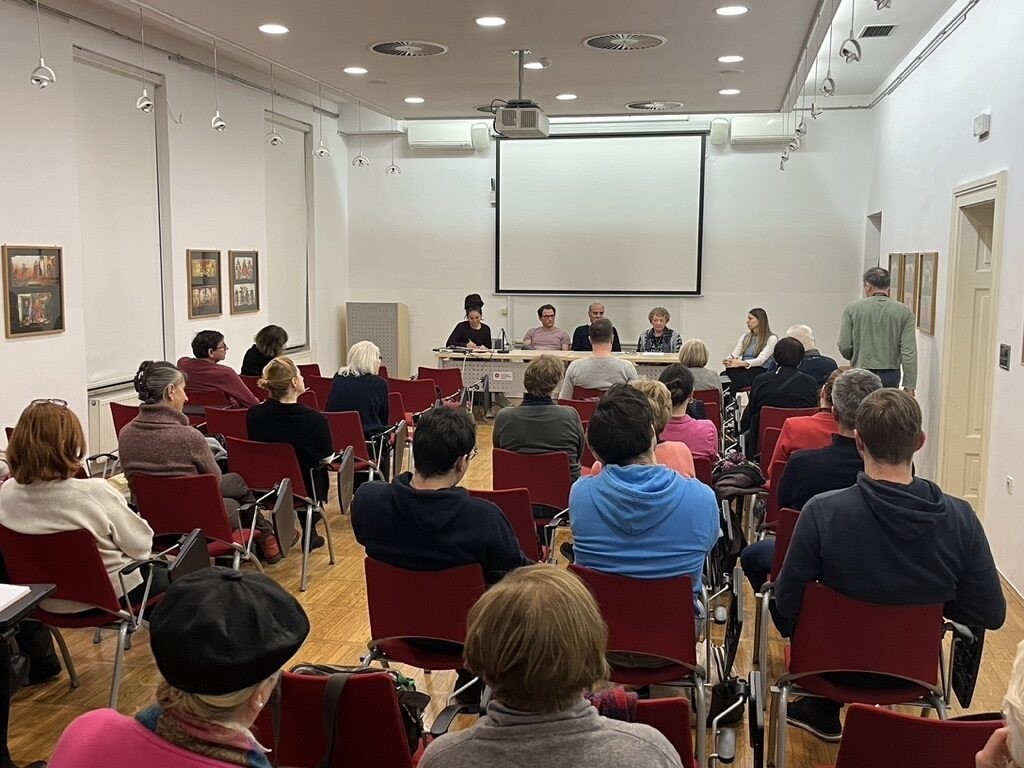The Piran salt pans are a unique feature on a global scale, with their ethnological and historical heritage intertwined with the value they bring in terms of landscape, habitat, and the ecosystem. Considering this importance, it is all the more contrasting that discourses centred around the Piran salt pans are rarely heard in Slovenia, particularly when it comes to the relation between their history and their present.
This event, entitled The Heritage of Salt Panning, which was organised by the Slovenian Ethnological Society with the support of other institutions, took place on 17 January 2023 in the administrative building of the Slovenian Ethnographic Museum, opened the space for a reflection on the actuality of the salt panning heritage.
The event participants first watched the documentary 30 years of the Museum of Salt Making, recorded in 2021 in the framework of the eponymous exhibition of the “Sergej Mašera” Maritime Museum in Piran and the Institute for the Protection of Cultural Heritage of Slovenia. The documentary is based on interviews with people who took part in the creation and the operation of the Museum of Salt Making during the earliest period. The documentary was followed by a panel discussion on the inheritance of salt pans and the current meaning of salt panning. The conversation was shaped by individuals who either contributed to the establishment and the operation of the Museum of Salt Making or continue to actively advocate for the heritage of salt panning: Mojca Ravnik, PhD (Institute of Slovenian Ethnology of the Research Centre of the Slovenian Academy of Sciences and Arts), Flavio Bonin, PhD, (“Sergej Mašera” Maritime Museum Piran), Mr Matjaž Kljun (Institute for the Protection of Cultural Heritage of Slovenia, Piran Regional Unit), Maja Bjelica, PhD (Institute for Philosophical and Religious Studies of the Science and Research Centre Koper), and the moderator, Daša Ličen, PhD (Institute of Slovenian Ethnology of the Research Centre of the Slovenian Academy of Sciences and Arts). Visitors were also able to join the discussion with the main speakers.
Ms Mojca Ravnik emphasised the historical importance of the decision to create the Museum of Salt Making at the end of the 1980s. In cooperation with the generation of saltmakers who were working in that period, it was possible to document specific salt panning knowledge, capturing the memories of the lively but also complex salt panning method based on a medieval process; their enthusiasm also allowed for the creation of an operating salt stock. She expressed her satisfaction with the presence of young people and with the interest in salt pans and salt panning expressed by the younger generation, and also asked them questions about their experience of salt panning in the context of today.
Mr Flavio Bonin recalled the prevalence and the economical, cultural, and family importance of salt panning throughout the Northern Adriatic, and explained the importance of the Piran salt pans for the development of Slovenian coastal towns in their present-day appearance. He also outlined historical fluctuations in the management and the influx of tourists visiting the salt pans. He expressed some concern about the current situation in the Piran salt pans and their deterioration, particularly noting that the situation might reach the point of no return when it comes to their restoration.
Mr Matjaž Kljun emphasised the will of individuals in terms of realising the ideas of the Museum of Salt Making, as well as the key role played by the enthusiastic saltmakers in having the then-emerging museum reinforce the salt production and revive the tradition of salt panning. He further explained that the salt panning landscape can mainly be maintained by its primary activity, i.e. salt panning. He therefore emphasised how urgent and also realistic it was to revive the production of salt in all areas of the salt pans, particularly in the parts that are currently abandoned, including Fontanigge, the southern part of the Sečovlje salt pans. He recalled that salt panning has significantly marked its space and its people, and that it is possible to continue developing it, due to the potential it holds.
Ms Maja Bjelica spoke about the activity of salt panning at an individual level from the point of view of a saltmaker. An often-overlooked aspect of an individual’s experience brings important insights for the environmental humanities as a scientific discipline engaged in the relation between the human and the environment, representing a field of practical reflection on the importance of salt pans for the past, present, and future.
The discussion with the audience raised the issue of a potential conflict between “nature and culture”. The participants expressed the concern that the management and legislation lead to having to choose between nature and culture, as well as the belief that current knowledge and modern management approaches support the synergistic nature preservation effects, respect for cultural heritage, and traditional methods of local food production, and that the methods to be used for reviving Piran salt pans must be sought in the same direction.
The event was organised by the Slovenian Ethnological Society which is co-financed by the Ministry of Culture of the Republic of Slovenia, with the support of the Slovenian Research Agency in the framework of the core research project entitled Grain of salt, crystallisation of coexistence: salt panning as an empirical environmental wisdom (J6-50196).
Written by: Jerneja Penca, PhD, Head of the Mediterranean Institute for Environmental Studies of the Science and Research Centre Koper
Photo credits: Primož Pipan, PhD (“Anton Melik” Geographical Institute of the Research Centre of the Slovenian Academy of Sciences and Arts), Jerneja Penca, PhD (Head of the Mediterranean Institute for Environmental Studies of the Science and Research Centre Koper), Ms Tina Palaić (Slovenian Ethnographical Museum)
 en
en Slovenščina
Slovenščina Italiano
Italiano